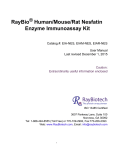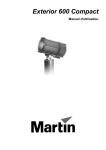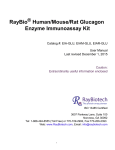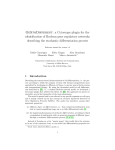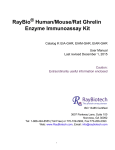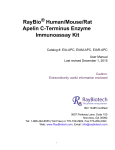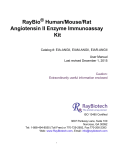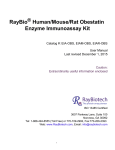Download Manual - RayBiotech, Inc.
Transcript
RayBio® Human/Mouse/Rat PYY Enzyme Immunoassay Kit Catalog #: EIA-PYY, EIAM-PYY, EIAR-PYY User Manual Last revised December 1, 2015 Caution: Extraordinarily useful information enclosed ISO 13485 Certified 3607 Parkway Lane, Suite 100 Norcross, GA 30092 Tel: 1-888-494-8555 (Toll Free) or 770-729-2992, Fax:770-206-2393 Web: www.RayBiotech.com, Email: [email protected] 1 Table of Contents Section Page # I. Introduction 3 II. General Description 4 III. How It Works 4 IV. Storage 5 V. Reagents 5 VI. Additional Materials Required 6 VII. Reagent Preparation A. Preparation of Plate and Anti-PYY Antibody B. Preparation of Biotinylated Peptide (Item F) C. Preparation of Standards D. Preparation of Positive Control E. Preparation of Samples F. Preparation of Wash Buffer and HRP-Strep 6 6 7 8 9 9 10 VIII. Assay Procedure 10 IX. Assay Procedure Summary 11 X. Calculation of Results A. Typical Data B. Sensitivity C. Detection Range D. Reproducibility E. Assay Diagram 12 12 12 12 12 13 XI. Specificity 14 XII. Select Publications 14 XIII. Troubleshooting Guide 15 Please read the entire manual carefully before starting your experiment 2 I. Introduction Peptide YY is a 36 amino acid peptide released by cells in the ileum and colon in response to feeding. It is also known as PYY, Peptide Tyrosine Tyrosine, or Pancreatic Peptide YY3-36. There are two major forms of Peptide YY: PYY1-36 and PYY3-36 which is the most common form of circulating PYY. Peptide YY3-36 (PYY) is a linear polypeptide consisting of 36 amino acids with structural homology to NPY and pancreatic polypeptide. Circulating PYY concentration increases postprandially and decreases by fasting. PYY exerts its action through NPY receptors, inhibits gastric motility and increases water and electrolyte absorption in the colon. PYY may also suppress pancreatic secretion. It is secreted by the neuroendocrine cells in the ileum and colon in response to a meal, and has been shown to reduce appetite. PYY works by slowing the gastric emptying; hence, it increases efficiency of digestion and nutrient absorption after meal. PYY has been shown to play an important role in obesity. Animal studies have shown that acute peripheral administration of PYY3-36 inhibits feeding of rodents and primates. Studies on Y2R-knockout mice have revealed that there is no anorectic effect on Y2R-knockot mice (Y2R is the receptor for PYY). These findings indicate that PYY3-36 has anorectic effect which is suggested to be mediated by Y2R. Studies on PYY-knockout mice have shown that they have higher fat mass and lower glucose tolerance when compared to control mice, indicating that PYY also plays very important role in energy homeostasis by balancing the food intake. Studies have also shown that obese people secrete less PYY than non-obese people. The anorectic effect of PYY represents a possible anti-obesity therapy in the future. 3 II. General Description The RayBio® PYY Enzyme Immunoassay (EIA) Kit is an in vitro quantitative assay for detecting PYY peptide based on the competitive enzyme immunoassay principle. In this assay, a biotinylated PYY peptide is spiked into the samples and standards. The samples and standards are then added to the plate, where the biotinylated PYY peptide competes with endogenous (unlabeled) PYY for binding to the antiPYY antibody. After a wash step, any bound biotinylated PYY then interacts with horseradish peroxidase (HRP)-streptavidin, which catalyzes a color development reaction. The intensity of the colorimetric signal is directly proportional to the amount of captured biotinylated PYY peptide and inversely proportional to the amount of endogenous PYY in the standard or samples. A standard curve of known concentration of PYY peptide can be established and the concentration of PYY peptide in the samples can be calculated accordingly. NOTE: Not compatible with plasma III. How It Works 4 IV. Storage The entire kit may be stored at -20°C to -80°C for up to 6 months from the date of shipment. For extended storage, it is recommended to store at -80°C. Avoid repeated freeze-thaw cycles. For prepared reagent storage, see table below. V. Reagents Component Size / Description Storage / Stability After Preparation PYY Microplate (Item A) 96 wells (12 strips x 8 wells) coated with secondary antibody. 1 month at 4°C* Wash Buffer Concentrate (20X) (Item B) 25 ml of 20X concentrated solution. 1 month at 4°C Standard PYY Peptide (Item C) 2 vials of Lyophilized PYY Peptide. 1 vial is enough to run each standard in duplicate. Do not store and reuse Anti-PYY Polyclonal Antibody (Item N) 2 vials of Lyophilized anti-PYY. Do not store and reuse Assay Diluent A (Item D) 30 ml, contains 0.09% sodium azide as preservative. Diluent for standards and serum or plasma. N/A Assay Diluent B (Item E) 15 ml of 5X concentrated buffer. Diluent for standards, cell culture media or other sample types, and HRP-Streptavidin. 1 month at 4°C Biotinylated PYY Peptide (Item F) 2 vials of Lyophilized Biotinylated PYY Peptide, 1 vial is enough to assay the whole plate. Do not store and reuse HRP-Streptavidin Concentrate (Item G) 600 µl 60X concentrated HRP-conjugated streptavidin. Do not store and reuse Positive Control (Item M) 1 vial of Lyophilized Positive Control. Do not store and reuse TMB One-Step Substrate Reagent (Item H) 12 ml of 3,3,5,5'-tetramethylbenzidine (TMB) in buffer solution. N/A Stop Solution (Item I) 8 ml of 0.2 M sulfuric acid. N/A *Return unused wells to the pouch containing desiccant pack, reseal along entire edge. 5 VI. Additional Materials Required 1. 2. 3. 4. 5. 6. 7. 8. 9. 10. 11. Microplate reader capable of measuring absorbance at 450 nm Precision pipettes to deliver 2 µl to 1 ml volumes Adjustable 1-25 ml pipettes for reagent preparation 100 ml and 1 liter graduated cylinders Absorbent paper Distilled or deionized water SigmaPlot software (or other software which can perform four-parameter logistic regression models) Tubes to prepare standard or sample dilutions Orbital shaker Aluminum foil Plastic wrap VII. Reagent Preparation Keep kit reagents on ice during reagent preparation steps. Note: Assay Diluent A should be used for dilution of samples, Item F and Item C when testing plasma or serum samples. 1X Assay Diluent B should be used for dilution of samples, Item F and Item C when testing cell culture media or other sample types. A. Preparation of Plate and Anti-PYY Antibody 1. Equilibrate plate to room temperature before opening the sealed pouch. 2. Label removable 8-well strips as appropriate for your experiment. 3. 5X Assay Diluent B (Item E) should be diluted 5-fold with deionized or distilled water. 4. Briefly centrifuge the anti-PYY antibody vial (Item N) and reconsititute with 55 µl of 1X Assay Diluent B to prepare the antibody concentrate. Pipette up and down to mix gently. 5. The antibody concentrate should then be diluted 100-fold with 1X Assay Diluent B. This is your anti-PYY antibody working solution, which will be used in step 2 of Assay Procedure (Section VIII). 6 Note: The following steps may be done during the antibody incubation procedure (step 2 of Assay Procedure) B. Preparation of Biotinylated PYY (Item F) 5. Briefly centrifuge the vial of Biotinylated PYY (Item F) and reconstitute with 20 µl of ddH2O before use. 6. See the image below for proper preparation of Item F. Transfer the entire contents of the Item F vial into a tube containing 10 ml of the appropriate Assay Diluent. This is your Working Stock of Item F. Pipette up and down to mix gently. The final concentration of biotinylated PYY will be 80 pg/ml. a. Second Dilution of Item F for Standards: Add 2 ml of Working Stock Item F to 2 ml of the appropriate Assay Diluent. The final concentration of biotinylated PYY will be 40 pg/ml. b. Second Dilution of Item F for Positive Control: Add 100 µl of Working Stock Item F to 100 µl of the prepared Positive Control (Item M). (See section D for Positive Control preparation) The final concentration of biotinylated PYY will be 40 pg/ml. c. Second Dilution of Item F for samples: Add 125 µl of Working Stock Item F to 125 µl of prepared sample (see section E for sample preparation). This is a 2-fold dilution of your sample. The final concentration of biotinylated PYY will be 40 pg/ml. 7 C. Preparation of Standards 7. Label 6 microtubes with the following concentrations: 1,000 pg/ml, 250 pg/ml, 62.5 pg/ml, 15.6 pg/ml, 3.91 pg/ml and 0 pg/ml. Pipette 300 µl of PYY Item F working solution (prepapred in step 6a) into each tube, except the 1,000 pg/ml It is very important to make sure the concentration of biotinylated PYY is 40 pg/ml in all standards. 8. Briefly centrifuge the vial of PYY Standard (Item C). Reconstitute with 10 µl of ddH2O and briefly vortex if desired. Pipette 6 µl of Item C and 594 µl of 40 pg/ml biotinylated PYY working solution (prepapred in step 6a) into the tube labeled 1,000 pg/ml. Mix thoroughly. This solution serves as the first standard (1,000 pg/ml PYY standard, 40 pg/ml biotinylated PYY). 9. To make the 250 pg/ml standard, pipette 100 µl of the 1,000 pg/ml PYY standard into the tube labeled 250 pg/ml. Mix thoroughly. 10. Repeat this step with each successive concentration, preparing a dilution series as shown in the illustration below. Each time, use 300 µl of biotinylated PYY and 50 µl of the prior concentration until the 3.91 pg/ml is reached. Mix each tube thoroughly before the next transfer. 8 D. Positive Control Preparation 11. Briefly centrifuge the Positive Control vial (Item M) and reconstitute with 100 µl of ddH2O. 12. Refer to step 6b. This is a 2-fold dilution of the Positive Control. The final concentration of biotinylated PYY should still be 40 pg/ml. The Positive Control is a cell culture media sample that serves as a system control to verify that the kit components are working. The resulting OD will not be used in any calculations; if no positive competition is observed please contact RayBiotech Technical Support. The Positive Control may be diluted further if desired, but be sure the final concentration of biotinylated PYY is 40 pg/ml. E. Sample Preparation NOTE: Not compatiable with plasma samples 13. If you wish to perform a 2-fold dilution of your sample, proceed to step 6c. If you wish to perform a higher dilution of your sample, dilute your sample with the appropriate Assay Diluent before performing step 6c. EXAMPLE (to make a 4-fold dilution of sample): a. Dilute sample 2-fold (62.5 µl of sample + 62.5 µl of the appropriate Assay Diluent.). b. Perform step 6c (125 µl of working solution Item F + 125 µl of sample prepared above). The total volume is 250 µl, enough for duplicate wells on the microplate. It is very important to make sure the final concentration of the biotinylated PYY is 40 pg/ml. Note: Optimal sample dilution factors should be determined empirically, however you may reference below for recommended dilution factors for serum: Human=8X Mouse=32X Rat=32X. If you have any questions regarding the recommendended dilutions you may contact technical support at 888-494-8555 or [email protected]. 9 F. Preparation of Wash Buffer and HRP 14. If Item B (20X Wash Concentrate) contains visible crystals, warm to room temperature and mix gently until dissolved. 15. Dilute 20 ml of Wash Buffer Concentrate into deionized or distilled water to yield 400 ml of 1X Wash Buffer. 16. Briefly centrifuge the HRP-Streptavidin vial (Item G) before use. 17. Dilute the HRP-Streptavidin concentrate 60-fold with 1X Assay Diluent B. Note: do not use Assay Diluent A for HRP-Streptavidin preparation in step 17 VIII. Assay Procedure 1. Keep kit reagents on ice during reagent preparation steps. It is recommended that all standards and samples be run at least in duplicate. 2. Add 100 µl of Anti-PYY Antibody (Item N) (See Reagent Preparation step 3) to each well. Incubate for 1.5 hours at room temperature with gentle shaking (1-2 cycle/sec). You may also incubate overnight at 4ºC. 3. Discard the solution and wash wells 4 times with 1X Wash Solution Buffer (200300 µl each). Washing may be done with a multichannel pipette or an automated plate washer. Complete removal of liquid at each step is essential to good assay performance. After the last wash, remove any remaining Wash Buffer by aspirating or decanting. Invert the plate and blot it against clean paper towels. 4. Add 100 µl of each standard (see Reagent Preparation Section C), Positive Control (see Reagent Preparation Section D) and sample (see Reagent Preparation Section E) in appropriate wells. Be sure to include a blank well (Assay Diluent only). Cover wells and incubate for 2.5 hours at room temperature with gentle shaking (1-2 cycles/sec) overnight or at 4ºC. 5. Discard the solution and wash 4 times as directed in Step 3. 6. Add 100 µl of prepared HRP-Streptavidin solution (see Reagent Preparation step 7) to each well. Incubate for 45 minutes at room temperature with gentle 10 shaking. It is recommended that incubation time should not be shorter or longer than 45 minutes. 7. Discard the solution and wash 4 times as directed in Step 3. 8. Add 100 µl of TMB One-Step Substrate Reagent (Item H) to each well. Incubate for 30 minutes at room temperature in the dark with gentle shaking (1-2 cycles/sec). 9. Add 50 µl of Stop Solution (Item I) to each well. Read at 450 nm immediately. IX. Assay Procedure Summary 1. Prepare all reagents, samples and standards as instructed. 2. Add 100 µl anti-PYY to each well. Incubate 1.5 hours at room temperature or overnight at 4ºC. 3. Add 100 µl standard or sample to each well. Incubate 2.5 hours at room temperature or overnight at 4ºC. 4. Add 100 µl prepared Streptavidin solution. Incubate 45 minutes at room temperature. 5. Add 100 µl TMB One-Step Substrate Reagent to each well. Incubate 30 minutes at room temperature. 6. Add 50 µl Stop Solution to each well. Read at 450 nm immediately. 11 X. Calculation of Results Calculate the mean absorbance for each set of duplicate stands, controls, and samples and subtract the blank optical density. Plot the standard curve using SigmaPlot software (or other software which can perform four-parameter logistic regression models), with standard concentration on the x-axis and percentage of absorbance (see calculation below) on the y-axis. Draw the best-fit curve through the standard points. Percentage absorbance = (B-blank OD)/B 0-blank OD) where B = OD of sample or standard and B0 = OD of zero standard (total binding) A. Typical Data These standard curves are for demonstration only. A standard curve must be run with each assay. B. Sensitivity The minimum detectable concentrations of PYY is 2.84 pg/ml. C. Detection Range 0.1-1,000 pg/ml D. Reproducibility Intra-Assay: CV<10% Inter-Assay: CV<15% 12 E. Assay Diagram Recommended Plate Layout: Key: Blank = Buffer Only Total Binding = Biotin-PYY only Standard 1 = 1000 pg/ml Standard 2 = 250 pg/ml Standard 3 = 62.5 pg/ml Standard 4 = 15.6 pg/ml Standard 5 = 3.91 pg/ml Pos Control = Biotin with Item M 13 XI. Specificity Cross Reactivity: This EIA kit shows no cross-reactivity with any of the cytokines tested: Ghrelin, Nesfatin, Angiotensin II, NPY and APC. This kit detects the 1-36 form. The 3-36 form may also be detected, but this has not been conclusively tested. XIV. Publications Citing This Product 1. Bar F., et al. Carboxypeptidase E Modulates Intestinal Immune Homeostasis and Protects against Experimental Colitis in Mice. PLOS One. Published: July 22, 2014. DOI: 10.1371/journal.pone.0102347 Species: Mouse Sample Type: Conditioned Media 2. Hand K., et al. Hormone profiling in a novel enteroendocrine cell line pGIP/neo: STC-1. METABOLISM CLINICAL AND EXPERIMENTAL 61 (2012) 1683–1686 Species: Mouse Sample Type: Conditioned Media 3. Lin N, Cai DL, Jin D, Chen Y, Shi JJ. Ginseng Panaxoside Rb1 Reduces Body Weight in Diet-Induced Obese Mice. Cell Biochem Biophys. Cell Biochem Biophys (2014) 68:189–194 DOI 10.1007/s12013-013-9688-3 Species: Mouse Sample Type: Serum 14 XIII. Troubleshooting Guide Problem Cause Solution Inaccurate pipetting Improper standard dilution Check pipettes Briefly centrifuge Item C and dissolve the powder thoroughly by gently mixing Low signal Improper preparation of standard and/or biotinylated antibody Too brief incubation times Inadequate reagent volumes or improper dilution Briefly spin down vials before opening. Dissolve the powder thoroughly. Ensure sufficient incubation time; assay procedure step 2 may be done overnight Check pipettes and ensure correct preparation Large CV Inaccurate pipetting Air bubbles in wells Check pipettes Remove bubbles in wells High background Plate is insufficiently washed Contaminated wash buffer Review the manual for proper wash. If using a plate washer, ensure that all ports are unobstructed. Make fresh wash buffer Improper storage of the ELISA kit Stop solution Follow storage recomendations in sections IV and V. Keep substrate solution protected from light. Add stop solution to each well before reading plate Poor standard curve Low sensitivity 15 RayBio® ELISA Kits Over 2,000 ELISA kits available, visit www.RayBiotech.com/ELISA-Kits.html for details. This product is for research use only. ©2015 RayBiotech, Inc 16
















